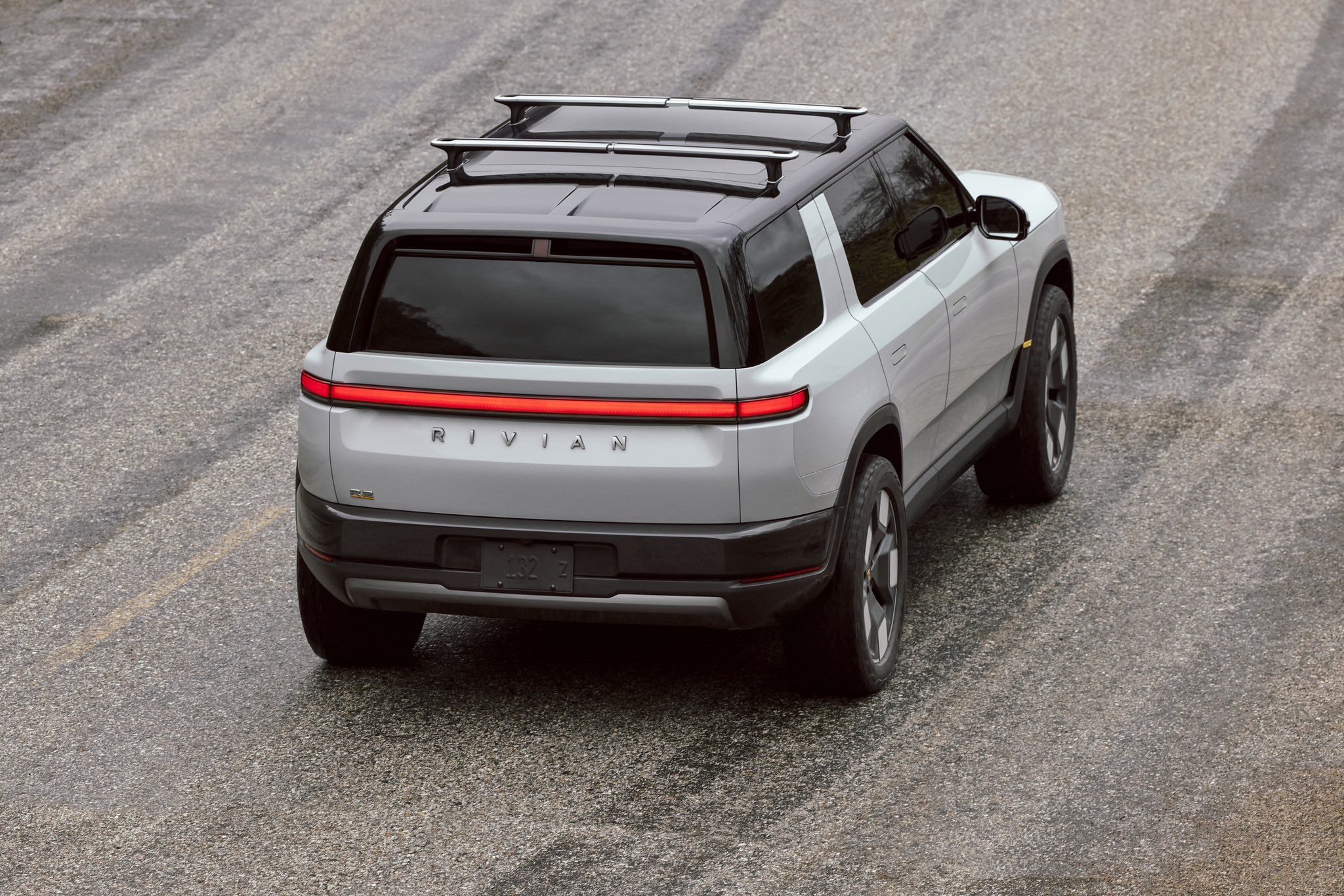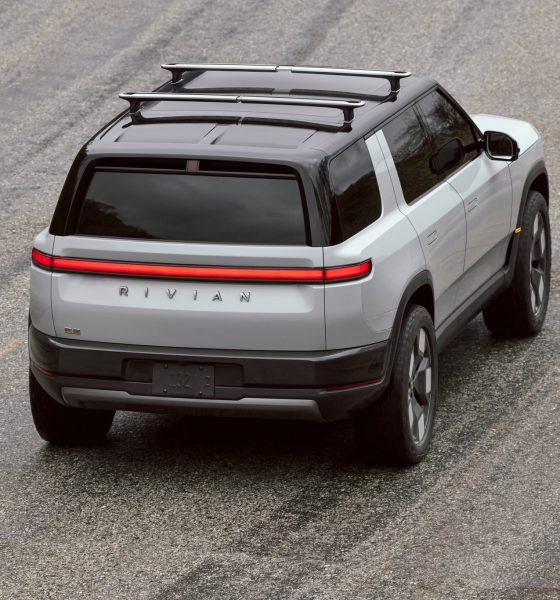

News
Tesla Lead Engineer urges Rivian to optimize R2 for existing Supercharger Network
The Rivian R2 has received much acclaim from the electric vehicle community, and this is highlighted by CEO RJ Scaringe’s announcement stating that the company had received over 68,000 reservations for the upcoming all-electric crossover SUV. But while the Rivian R2 has earned praise for its price, specs, and looks, one aspect of the vehicle has raised eyebrows — its charge port location.
As could be seen in the Rivian R2 prototype that was shown off onstage, as well as the R3 and R3X prototypes that were unveiled after, the electric vehicle maker has opted to equip its upcoming vehicles with a charge port located on the rear passenger side. This, as noted by EV owners, would result in the R2 taking up two spots at Tesla’s V3 and V2 Superchargers.
EV advocate Chris Hilbert, who attended the R2 event, claimed in a post on X that Rivian was able to provide him an answer behind the R2’s charge port location. As per Hilbert, “Rivian is counting on the charging infrastructure to adapt over the next two years. Tesla should not dictate the port location. They are expecting (the) charge port location to not matter by 2026. They are also expecting the future to be curbside charging,” Hilbert wrote, though he also noted that Rivian employees were receptive when he told them that the R2’s charge port location was the vehicle’s only flaw.
I stopped back at the theater to talk to many @Rivian employees tonight. I told them this is the only flaw of the vehicle and they were wrong on charge port location. They did listen to the feedback. They have 2 years to fix it. https://t.co/d9mTqhBFWs— Chris Hilbert (@Hilbe) March 8, 2024
The Rivian R2’s charge port location has since become a well-discussed topic in social media. On Friday morning, Tesla Cybertruck Lead Engineer Wes Morrill weighed in on the matter, encouraging Rivian to move the charge port of the R2 to the rear driver’s side instead. While the Tesla Lead Engineer admitted that Tesla’s V4 Superchargers have longer cables that could accommodate electric vehicle charge port doors in any location, Tesla’s existing network of V3 and V2 Superchargers — which number over 50,000 — are optimized for vehicles whose charge port doors are located in the rear driver’s side.
“RJ Scaringe and Nick Kalayjian, cool product. Great looking prototypes. I know how these things go. There is still time to move the charge port location. It will take some re-engineering but the tools are not kicked off yet. This location will forever doom all Rivian owners to be the jerk taking two spots at a Tesla charger. Don’t do that to your customers.
@RJScaringe @nkalayjian cool product. Great looking prototypes. I know how these things go, there is still time to move the charge port location. It will take some re-engineering but the tools are not kicked off yet. This location will forever doom all Rivian owners to be the… https://t.co/T7wiylQhQH— Wes (@wmorrill3) March 8, 2024
“I know the Rivian Network has been installed to support the front left/rear right, but there are <500 Adventure Network fast charge handles vs more than 50,000 Supercharger handles. You’ve done the right thing for customers moving to NACS. Take it the last mile and put it in a location that works seamlessly with existing infrastructure. Can be the front right if you are trying to optimize for street parking. Looking forward to charging harmoniously with a great-looking EV,” Morrill wrote in a post on X.
Rivian has highlighted that it puts consumers’ feedback front and center when it designs its vehicles. Considering the substantial requests from EV community members calling for Rivian to move the location of the R2’s charge port door, it would truly be surprising if the electric vehicle maker stands firm and still releases the upcoming all-electric crossover SUV with its original charge port location.
Don’t hesitate to contact us with news tips. Just send a message to simon@teslarati.com to give us a heads up.

News
Tesla China delivery centers look packed as 2025 comes to a close
Needless to say, it appears that Tesla China seems intent on ending 2025 on a strong note.

Tesla’s delivery centers in China seem to be absolutely packed as the final days of 2025 wind down, with photos on social media showing delivery locations being filled wall-to-wall with vehicles waiting for their new owners.
Needless to say, it appears that Tesla China seems intent on ending 2025 on a strong note.
Full delivery center hints at year-end demand surge
A recent image from a Chinese delivery center posted by industry watcher @Tslachan on X revealed rows upon rows of freshly prepared Model Y and Model 3 units, some of which were adorned with red bows and teddy bears. Some customers also seem to be looking over their vehicles with Tesla delivery staff.
The images hint at a strong year-end push to clear inventory and deliver as many vehicles as possible. Interestingly enough, several Model Y L vehicles could be seen in the photos, hinting at the demand for the extended wheelbase-six seat variant of the best-selling all-electric crossover.
Strong demand in China
Consumer demand for the Model Y and Model 3 in China seems to be quite notable. This could be inferred from the estimated delivery dates for the Model 3 and Model Y, which have been extended to February 2026 for several variants. Apart from this, the Model Y and Model 3 also continue to rank well in China’s premium EV segment.
From January to November alone, the Model Y took China’s number one spot in the RMB 200,000-RMB 300,000 segment for electric vehicles, selling 359,463 units. The Model 3 sedan took third place, selling 172,392. This is quite impressive considering that both the Model Y and Model 3 are still priced at a premium compared to some of their rivals, such as the Xiaomi SU7 and YU7.
With delivery centers in December being quite busy, it does seem like Tesla China will end the year on a strong note once more.
News
Tesla Giga Berlin draws “red line” over IG Metall union’s 35-hour week demands
Factory manager André Thierig has drawn a “red line” against reducing Giga Berlin’s workweek to 35 hours, while highlighting that Tesla has actually increased its workers’ salaries more substantially than other carmakers in the country.

Tesla Giga Berlin has found itself in a new labor dispute in Germany, where union IG Metall is pushing for adoption of a collective agreement to boost wages and implement changes, such as a 35-hour workweek.
In a comment, Giga Berlin manager André Thierig drew a “red line” against reducing Giga Berlin’s workweek to 35 hours, while highlighting that Tesla has actually increased its workers’ salaries more substantially than other carmakers in the country.
Tesla factory manager’s “red line”
Tesla Germany is expected to hold a works council election in 2026, which André Thierig considers very important. As per the Giga Berlin plant manager, Giga Berlin’s plant expansion plans might be put on hold if the election favors the union. He also spoke against some of the changes that IG Metall is seeking to implement in the factory, like a 35-hour week, as noted in an rbb24 report.
“The discussion about a 35-hour week is a red line for me. We will not cross it,” Theirig said.
“(The election) will determine whether we can continue our successful path in the future in an independent, flexible, and unbureaucratic manner. Personally, I cannot imagine that the decision-makers in the USA will continue to push ahead with the factory expansion if the election results favor IG Metall.”
Giga Berlin’s wage increase
IG Metall district manager Jan Otto told the German news agency DPA that without a collective agreement, Tesla’s wages remain significantly below levels at other German car factories. He noted the company excuses this by referencing its lowest pay grade, but added: “The two lowest pay grades are not even used in car factories.”
In response, Tesla noted that it has raised the wages of Gigafactory Berlin’s workers more than their German competitors. Thierig noted that with a collective agreement, Giga Berlin’s workers would have seen a 2% wage increase this year. But thanks to Tesla not being unionized, Gigafactory Berlin workers were able to receive a 4% increase, as noted in a CarUp report.
“There was a wage increase of 2% this year in the current collective agreement. Because we are in a different economic situation than the industry as a whole, we were able to double the wages – by 4%. Since production started, this corresponds to a wage increase of more than 25% in less than four years,” Thierig stated.
News
Tesla is seeing a lot of momentum from young Koreans in their 20s-30s: report
From January to November, young buyers purchased over 21,000 Teslas, putting it far ahead of fellow imported rivals like BMW and Mercedes-Benz.

Tesla has captured the hearts of South Korea’s 20s-30s demographic, emerging as the group’s top-selling imported car brand in 2025. From January to November, young buyers purchased over 21,000 Teslas, putting it far ahead of fellow imported rivals like BMW and Mercedes-Benz.
Industry experts cited by The Economist attributed this “Tesla frenzy” to fandom culture, where buyers prioritize the brand over traditional car attributes, similar to snapping up the latest iPhone.
Model Y dominates among young buyers
Data from the Korea Imported Automobile Association showed that Tesla sold 21,757 vehicles to the 20s-30s demographic through November, compared to BMW’s 13,666 and Mercedes-Benz’s 6,983. The Model Y led the list overwhelmingly, with variants like the standard and Long Range models topping purchases for both young men and women.
Young men bought around 16,000 Teslas, mostly Model Y (over 15,000 units), followed by Model 3. Young women followed a similar pattern, favoring Model Y (3,888 units) and Model 3 (1,083 units). The Cybertruck saw minimal sales in this group.
The Model Y’s appeal lies in its family-friendly SUV design, 400-500 km range, quick acceleration, and spacious cargo, which is ideal for commuting and leisure. The Model 3, on the other hand, serves as an accessible entry point with lower pricing, which is valuable considering the country’s EV subsidies.
The Tesla boom
Experts described Tesla’s popularity as “fandom culture,” where young buyers embrace the brand despite criticisms from skeptics. Professor Lee Ho-geun called Tesla a “typical early adopter brand,” comparing purchases to iPhones.
Professor Kim Pil-soo noted that young people view Tesla more as a gadget than a car, and they are likely drawn by marketing, subsidies, and perceived value. They also tend to overlook news of numerous recalls, which are mostly over-the-air software updates, and controversies tied to the company.
Tesla’s position as Korea’s top import for 2025 seems secured. As noted by the publication, Tesla’s December sales figures have not been reported yet, but market analysts have suggested that Tesla has all but secured the top spot among the country’s imported cars this year.








